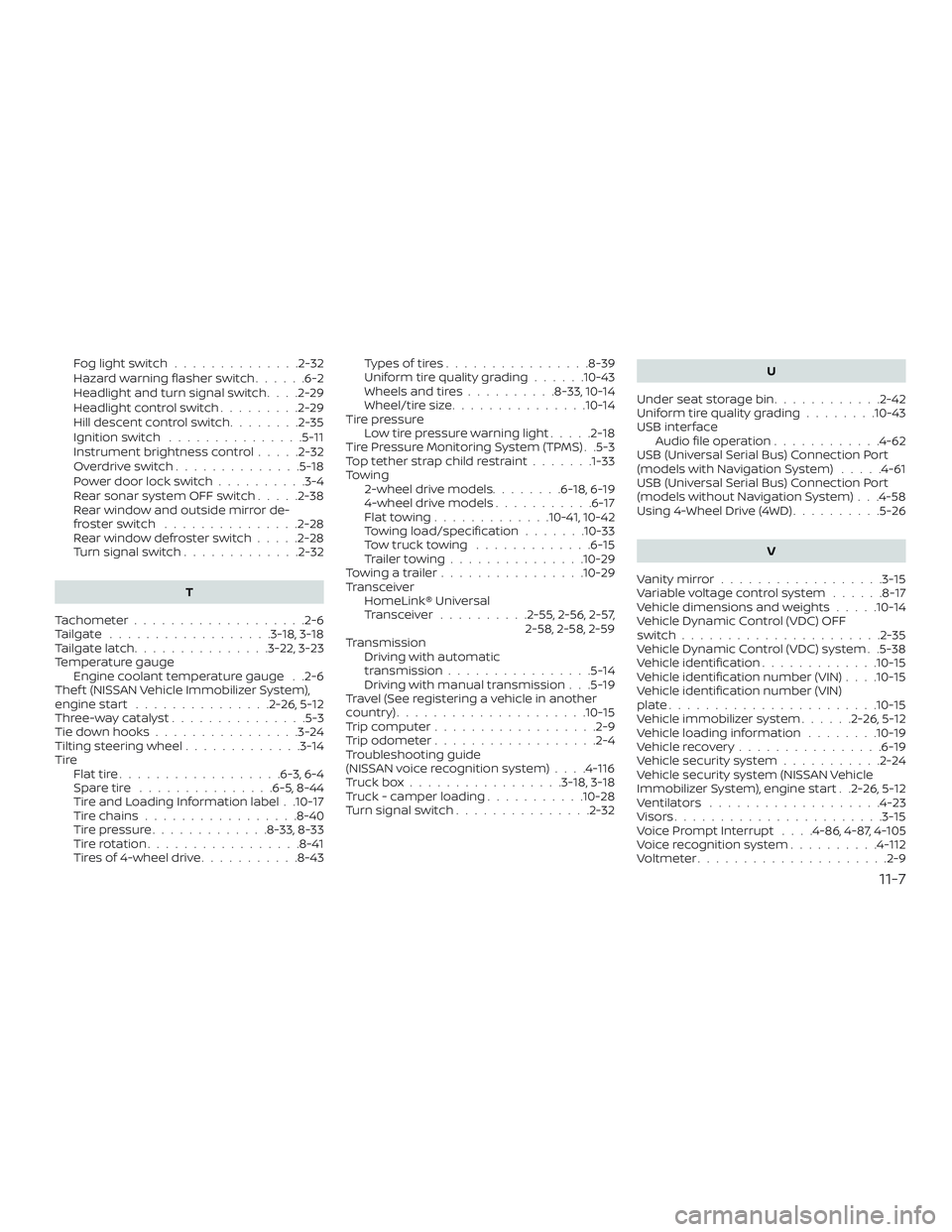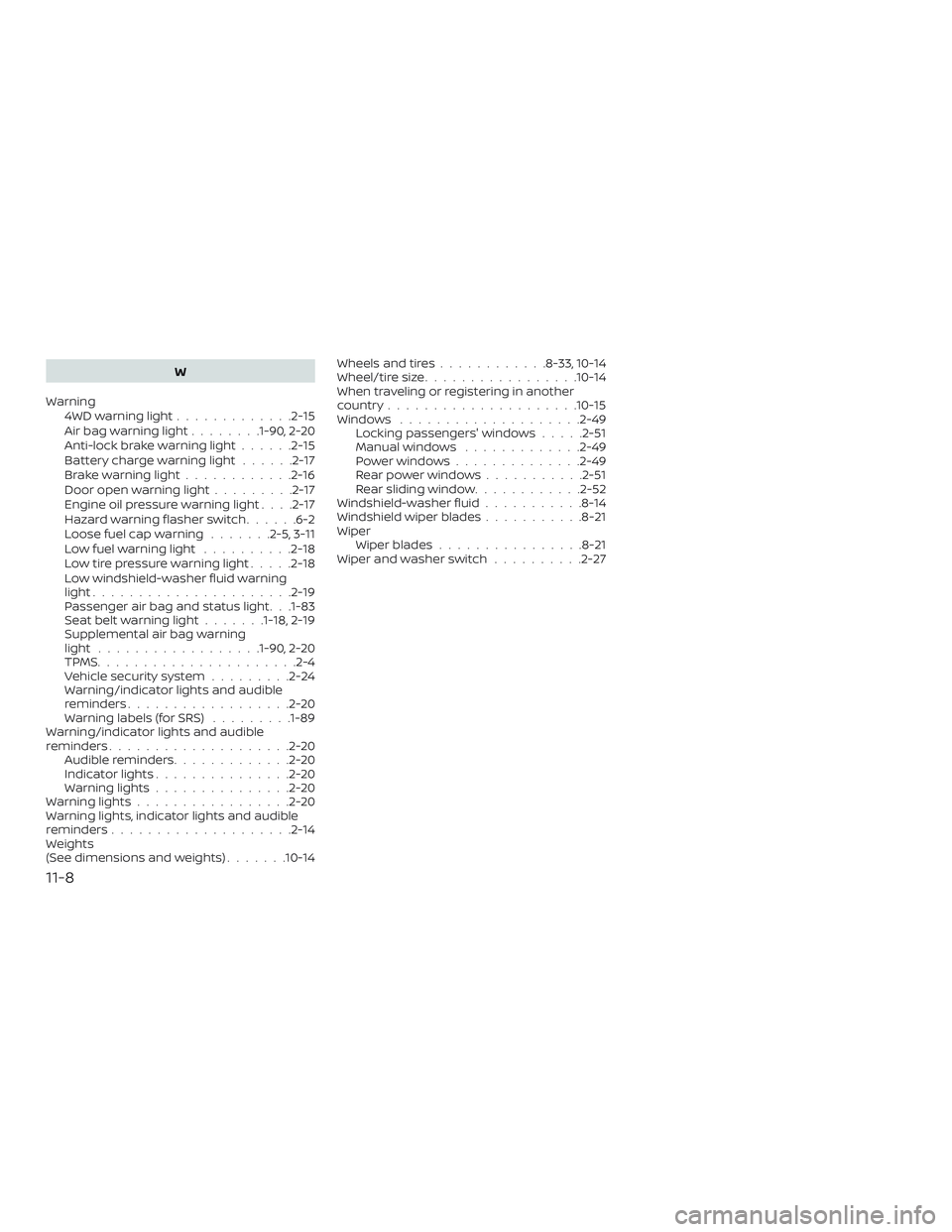2019 NISSAN FRONTIER tire size
[x] Cancel search: tire sizePage 435 of 516

CAUTION
∙ Do not use tire chains on a TEMPO-RARY FULL SIZE spare tire. Tire chains
will not fit properly and may cause
damage to the vehicle.
∙ Use of the TEMPORARY FULL SIZE spare tire on a vehicle that has tires
larger than were originally equipped
can affect the 4WD System. This may
result in a circumference difference
between tires on front and rear axles
which can cause the 4WD system to
automatically place the vehicle in
2WD and flash the 4WD light. When the
TEMPORARY FULL SIZE spare tire is re-
placed with a tire that matches all
other tires on the vehicle, and all tires
are properly inflated the 4WD system
will operate normally.
Do-it-yourself8-45
Page 466 of 516

WHEELS AND TIRES
Wheel TypeOffset in (mm)Size
Steel 0.79 (20)15 x 6.5JJ
Steel 1.18 (30)16 x 7JJ
Aluminum 1.18 (30)16 x 7J
Aluminum 1.18 (30)18 x 7.5J
Tires Size
235/75R15
P265/70R16 P265/75R16
P265/60R18
Spare tire Size
Steel Full size
Alloy 16” Full size
Alloy 18” P265/70R16
DIMENSIONS AND WEIGHTS
Overall length
Short wheel base in(mm)205.5 (5,220)
Long wheel base in (mm)219.4 (5,574)
Overall width in
(mm) 72.8 (1,850)
Overall height (includes
roof rails) Crew Cab models S, SV, DR and SL in
(mm) 70.1 (1,780)
Pro-4X in
(mm) 73.9 (1,878)
King Cab® models S and SV I-4 in
(mm) 68.7 (1,745)
SV, DR and Pro-4X in (mm)69.7 (1,770)
Track Width Front and rear in
(mm) 61.8 (1,570)
Wheelbase Short wheel base in(mm)125.9 (3,200)
Long wheel base in (mm)139.9 (3,554)
Gross vehicle weight
rating lbs.
(kg) Refer to the “F.M.V.S.S./
C.M.V.S.S. certification
label” on the center pil-
lar between the driver’s
side front and rear
doors.
Gross axle weight rat-
ing
Front lbs.
(kg)
Rear lbs.
(kg)
10-14Technical and consumer information
Page 481 of 516

The total cargo load should not exceed the
truck’s pay load weight rating and the
camper’s center of gravity should fall within
the truck’s recommended center of gravity
location when installed.
WARNING
Overloading or improper loading can
adversely affect vehicle handling, brak-
ing and performance and may lead to
accidents.
VEHICLE LOAD WEIGHT CAPACITY
The vehicle payload weight capacity
shown on the Tire and Loading Information
label, refer to “Tire and Loading Information
label” in this section, indicates the maxi-
mum total weight of passengers, optional
equipment (air conditioning, trailer hitch,
etc.) and cargo that your vehicle is de-
signed to carry.
Before driving a loaded vehicle, confirm
that you do not exceed the GVWR or the
GAWR for your vehicle. For additional infor-
mation, refer to ’’Vehicle loading informa-
tion’’ in this section.
Also check tires for proper inflation pres-
sures. For additional information, refer to
the Tire and Loading Information label.
MEASUREMENT OF WEIGHTS
Secure loose items to prevent
weight shif ts that could affect the
balance of your vehicle. When the ve-
hicle is loaded, drive to a scale and
weigh the front and the rear wheels
separately to determine axle loads.
Individual axle loads should not ex-
ceed either of the GAWR. The total of
the axle loads should not exceed the
GVWR. These ratings are given on
the vehicle certification label. If
weight ratings are exceeded, move
or remove items to bring all weights
below the ratings.
WARNING
∙ Overloading or improper loading of atrailer and its cargo can adversely af-
fect vehicle handling, braking and
performance and may lead to
accidents.
∙ Do not tow a trailer when the TEMPO- RARY FULL SIZE spare tire is installed.
CAUTION
∙ Do not tow a trailer or haul a heavyload for the first 500 mile (805 km).
Your engine, axle or other parts could
be damaged.
∙ For the first 500 miles (805 km) that you tow a trailer, do not drive over
50 mph (80 km/h) and do not make
starts at full throttle. This helps the
engine and other parts of your vehicle
wear in at the heavier loads.
Your new vehicle was designed to be used
primarily to carry passengers and cargo.
Remember that towing a trailer places ad-
ditional loads on your vehicle’s engine,
drive train, steering, braking and other sys-
tems.
TOWING A TRAILER
Technical and consumer information10-29
Page 490 of 516

Tire pressures
∙ When towing a trailer, inflate thevehicle tires to the recom-
mended cold tire pressure indi-
cated on the Tire and Loading In-
formation label.
∙ Trailer tire condition, size, load rat- ing and proper inflation pressure
should be in accordance with the
trailer and tire manufacturer’s
specifications.
Safety chains
Always use suitable safety chains between
your vehicle and the trailer. The safety
chains should be crossed and should be
attached to the hitch, not to the vehicle
bumper or axle. The safety chains can be
attached to the bumper if the hitch ball is
mounted to the bumper. Be sure to leave
enough slack in the chains to permit turn-
ing corners.
Trailer lights
CAUTION
When splicing into the vehicle electrical
system, a commercially available
power-type module/converter must be
used to provide power for all trailer
lighting. This unit uses the vehicle bat-
tery as a direct power source for all
trailer lights while using the vehicle tail
light, stop light and turn signal circuits
as a signal source. The
module/converter must draw no more
than 15 milliamps from the stop and tail
lamp circuits. Using a
module/converter that exceeds these
power requirements may damage the
vehicle’s electrical system. See a repu-
table trailer dealer to obtain the proper
equipment and to have it installed.
Trailer lights should comply with federal
and/or local regulations. For assistance in
hooking up trailer lights, it is recommended
that you visit a NISSAN dealer or reputable
trailer dealer. Vehicles equipped with the
optional trailer tow package are equipped
with a 7-pin trailer harness connector. A flat
4–pin harness is available from your dealer
for vehicles without a tow package. If your
trailer is equipped with a flat 4-pin connec- tor, an adapter will be needed to connect
the trailer lights to the vehicle. Adapters are
available at auto parts stores and hitch re-
tailers.Trailer brakes
If your trailer is equipped with a braking
system, make sure it conforms to federal
and/or local regulations and that it is prop-
erly installed.
Vehicles equipped with a 7–pin trailer har-
ness connector are pre-wired for a trailer
brake controller. It is recommended that
you visit a NISSAN dealer for a trailer brake
adapter harness.
WARNING
Never connect a trailer brake system di-
rectly to the vehicle brake system.
When towing a trailer load of 3,500 lbs.
(1587 kg) or more, trailers with a brake
system MUST be used. However, most
states require a separate braking system
on trailers with a loaded weight above a
specific amount. Make sure the trailer
meets the local regulations and the regu-
lations where you plan to tow.
Several types of braking systems are avail-
able.
10-38Technical and consumer information
Page 507 of 516

Foglightswitch..............2-32
Hazard warning flasher switch......6-2
Headlight and turn signal switch ....2-29
Headlightcontrolswitch.........2-29
Hill descent control switch ........2-35
Ignition switch ...............5-11
Instrument brightness control .....2-32
Overdriveswitch..............5-18
Power door lock switch ..........3-4
Rear sonar system OFF switch .....2-38
Rear window and outside mirror de-
frosterswitch ...............2-28
Rearwindowdefrosterswitch.....2-28
Turn signal switch .............2-32
T
Tachometer ...................2-6
Tailgate ..................3-18, 3-18
Tailgatelatch...............3-22,3-23
Temperature gauge Engine coolant temperature gauge . .2-6
Thef t (NISSAN Vehicle Immobilizer System),
engine start ...............2-26,5-12
Three-waycatalyst...............5-3
Tie down hooks ................3-24
Tilting steering wheel .............3-14
Tire Flattire..................6-3,6-4
Spare tire ...............6-5,8-44
Tire and Loading Information label . .10-17
Tire chains .................8-40
Tire pressure .............8-33,8-33
Tirerotation.................8-41
Tires of 4-wheel drive ...........8-43 Types of tires
................8-39
Uniform tire quality grading ......10-43
Wheels and tires ..........8-33,10-14
Wheel/tire size ...............10-14
Tire pressure Lowtirepressurewarninglight.....2-18
Tire Pressure Monitoring System (TPMS) . .5-3
Toptetherstrapchildrestraint.......1-33
Towing 2-wheel drive models ........6-18,6-19
4-wheel drive models ...........6-17
Flattowing.............10-41,10-42
Towing load/specification .......10-33
Towtrucktowing .............6-15
Trailertowing...............10-29
Towingatrailer................10-29
Transceiver HomeLink® Universal
Transceiver ..........2-55,2-56,2-57,
2-58, 2-58, 2-59
Transmission Driving with automatic
transmission ................5-14
Driving with manual transmission . . .5-19
Travel (See registering a vehicle in another
country) .....................10-15
Trip computer ..................2-9
Trip odometer ..................2-4
Troubleshooting guide
(NISSAN voice recognition system) ....4-116
Truckbox.................3-18,3-18
Truck - camper loading ...........10-28
Turn signal switch ...............2-32 U
Under seat storage bin ............2-42
Uniform tire quality grading ........10-43
USB interface Audio file operation ............4-62
USB (Universal Serial Bus) Connection Port
(models with Navigation System) .....4-61
USB (Universal Serial Bus) Connection Port
(models without Navigation System) . . .4-58
Using 4-Wheel Drive (4WD) ..........5-26
V
Vanitymirror..................3-15
Variablevoltagecontrolsystem......8-17
Vehicle dimensions and weights .....10-14
Vehicle Dynamic Control (VDC) OFF
switch......................2-35
Vehicle Dynamic Control (VDC) system . .5-38
Vehicle identification .............10-15
Vehicle identification number (VIN) . . . .10-15
Vehicle identification number (VIN)
p l
ate.......................10-15
Vehicle immobilizer system ......2-26,5-12
Vehicle loading information ........10-19
Vehiclerecovery................6-19
Vehicle security system ...........2-24
Vehicle security system (NISSAN Vehicle
Immobilizer System), engine start . .2-26, 5-12
Ventilators ...................4-23
Visors...................... .3-15
Voice Prompt Interrupt ....4-86,4-87,4-105
Voice recognition system ..........4-112
Voltmeter.................... .2-9
11-7
Page 508 of 516

W
Warning 4WDwarninglight.............2-15
Airbagwarninglight........1-90, 2-20
Anti-lock brake warning light ......2-15
Battery charge warning light ......2-17
Brakewarninglight............2-16
Door open warning light .........2-17
Engine oil pressure warning light ....2-17
Hazard warning flasher switch ......6-2
Loose fuel cap warning .......2-5,3-11
Lowfuelwarninglight ..........2-18
Low tire pressure warning light .....2-18
Low windshield-washer fluid warning
light......................2-19
Passenger air bag and status light. . .1-83
Seatbeltwarninglight.......1-18, 2-19
Supplemental air bag warning
light ..................1-90, 2-20
TPMS......................2-4
Vehicle security system .........2-24
Warning/indicator lights and audible
reminders ..................2-20
Warning labels (for SRS) .........1-89
Warning/indicator lights and audible
reminders ....................2-20
Audible reminders .............2-20
Indicatorlights...............2-20
Warninglights...............2-20
Warninglights.................2-20
Warning lights, indicator lights and audible
reminders ....................2-14
Weights
(See dimensions and weights) .......10-14Wheels and tires
............8-33,10-14
Wheel/tire size .................10-14
When traveling or registering in another
country .....................10-15
Windows ....................2-49 Locking passengers' windows .....2-51
Manual windows .............2-49
Powerwindows..............2-49
Rearpowerwindows...........2-51
Rearslidingwindow............2-52
Windshield-washer fluid ...........8-14
Windshield wiper blades ...........8-21
Wiper Wiper blades ................8-21
Wiper and washer switch ..........2-27
11-8